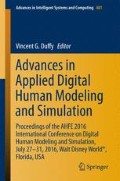Abstract
NASA’s endeavors in human spaceflight rely on extensive volumes of human-systems integration requirements to ensure mission success. These requirements protect space hardware accommodation for the full range of potential crewmembers, but cannot cover every possible action and contingency in detail. This study was undertaken in response to questions from various strength requirement users who were unclear how to apply idealized strength requirements that did not map well to the complex loading scenarios that crewmembers would encounter. Three of the most commonly occurring questions from stakeholders were selected to be investigated by human testing and human modeling. Preliminary findings indicate that deviation from nominal postures can affect compliance with strength requirements positively or negatively, depending on the nature of the deviation. Human modeling offers some avenues for quickly addressing requirement verification questions, but is limited by the fidelity of the model and environment.
Access this chapter
Tax calculation will be finalised at checkout
Purchases are for personal use only
References
Human System Integration Requirement Document (Rev E), Constellation Program 70024. National Aeronautics and Space Administration (2010)
ISS Crew Transportation Services Requirements Document (Rev C), Commercial Crew Program 1130. National Aeronautics and Space Administration (2013)
University of Michigan Center for Ergonomics, 3D Static Strength Prediction Program User’s Manual. Retrieved from http://umich.edu/~ioe/3DSSPP/Manual_606.pdf (2014)
Kroemer, K.H.E., Kroemer, H.B., Kroemer-Elbert, K.E.: Ergonomics: How to Design for Ease and Efficiency, 2nd edn. Prentice Hall, Upper Saddle River (2001)
Chaffin, D.B., Andersson, G.B., Martin, B.J.: Occupational Biomechanics, 3rd edn. Wiley, New York (1999)
Human Integration Design Handbook, NASA/SP 2010-3407. National Aeronautics and Space Administration (2010)
Author information
Authors and Affiliations
Corresponding author
Editor information
Editors and Affiliations
Rights and permissions
Copyright information
© 2017 Springer International Publishing Switzerland
About this paper
Cite this paper
England, S., Rajulu, S. (2017). Application of Strength Requirements to Complex Loading Scenarios. In: Duffy, V. (eds) Advances in Applied Digital Human Modeling and Simulation. Advances in Intelligent Systems and Computing, vol 481. Springer, Cham. https://doi.org/10.1007/978-3-319-41627-4_15
Download citation
DOI: https://doi.org/10.1007/978-3-319-41627-4_15
Published:
Publisher Name: Springer, Cham
Print ISBN: 978-3-319-41626-7
Online ISBN: 978-3-319-41627-4
eBook Packages: EngineeringEngineering (R0)

